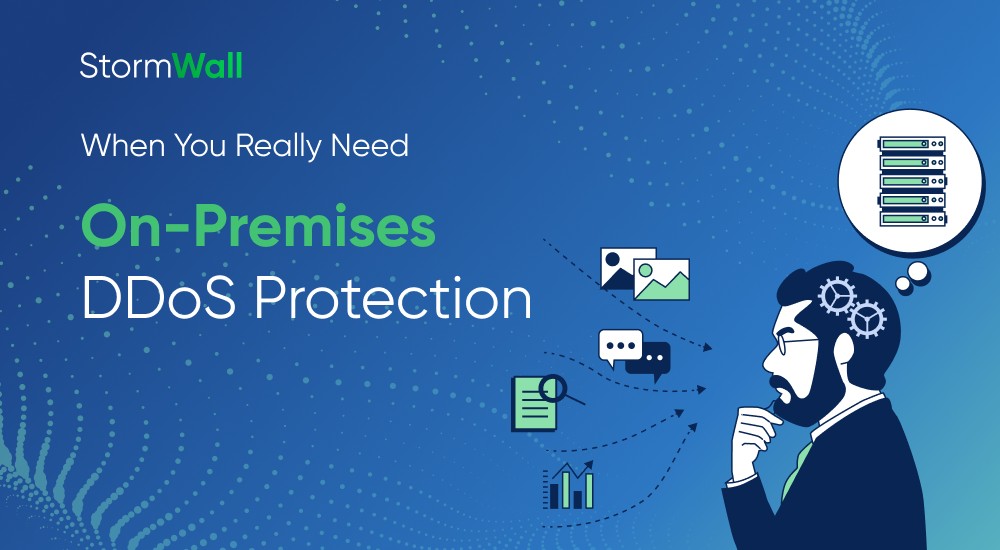DDoS attacks are only getting bigger and bolder—as our latest reports clearly show. In this landscape, the question for security leaders isn’t whether to defend against attacks—it’s where to deploy that defense.
This article explores the real-world pros and cons of on-premises DDoS protection—a model that remains relevant in high-security environments, even as cloud and hybrid solutions gain popularity.

Why It Still Matters
Despite the rise of cloud-first strategies, hardware-based protection isn’t going away. IDC reports that global spending on security appliances reached $5.1 billion in Q4 2024, with strong momentum in Europe, the Middle East, and Africa. That’s not surprising: for many organizations, full control over traffic, predictable latency, and strict compliance requirements make on-premises DDoS protection the only viable option.
What On-Premise DDoS Protection Really Means
In an on-prem setup, your DDoS mitigation engine—a dedicated appliance—sits directly in your network path. It inspects and filters all incoming traffic before it reaches your internal systems. Nothing is routed to a third-party scrubbing center. Everything—policies, logs, traffic data—stays within your own infrastructure.
This is very different from cloud-based services, which divert traffic offsite for inspection, or hybrid models that only route large floods externally. With on-premises DDoS protection, you’re fully responsible for capacity planning, hardware management, and real-time monitoring.
Who Needs On-Premises Protection
On-premises DDoS protection hasn’t gone extinct for a reason. Some sectors just can’t compromise on traffic control. Banks and financial institutions, for example, need real-time filtering and strict regulatory compliance—especially when milliseconds can impact millions. Government agencies and military systems often operate under mandates that require total data sovereignty, keeping everything within closed environments.
Then there are large enterprises in sectors like energy, healthcare, and telecom. For them, it’s not just about security; it’s about auditability, uptime guarantees, and the kind of deterministic performance cloud setups can’t always deliver. And let’s not forget gaming platforms and VoIP services, where a few milliseconds of latency or jitter can result in lost users and SLA penalties. For all these players, having DDoS mitigation right at the perimeter remains the safer bet.
Key Advantages of On-Prem DDoS Protection
The biggest draw is control—on-prem gives you full command over what comes in and how it’s handled. There’s no sharing of traffic logs or handing off decisions to external scrubbing centers. Everything stays internal, which is a key requirement for firms bound by GDPR, PCI-DSS, or national security standards.
Performance is another strong point. Since the traffic doesn’t need to be rerouted through a distant data center, latency stays low and predictable. That’s critical in sectors where timing is everything.
You also get the flexibility to fine-tune rules down to the packet level, plug directly into internal monitoring systems, and tailor responses without relying on someone else’s support schedule. And because the hardware lives in your rack, you know exactly what it can handle—no surprises, just planned capacity.
What’s the Catch? Main Cons of On-Premise Anti-DDoS Solutions
Of course, that level of control comes with a price tag. Setting up a robust on-prem DDoS defense means serious upfront investment—hardware, support contracts, and the human capital to run it all. And when a massive volumetric attack rolls in, your defenses are only as good as your upstream capacity. If the internet pipe gets saturated before the appliance sees the traffic, it’s game over—no matter how advanced the box is.
There’s also the operational overhead. Unlike cloud platforms that scale on demand and evolve automatically, on-prem systems need constant care. That includes tuning signatures, updating firmware, and keeping up with emerging threat tactics—ideally with a dedicated team that knows the ins and outs of network security.
Bottom Line: Is It Right for You?
If your organization prioritizes total control, zero trust in third-party infrastructure, and consistent low-latency performance, on-prem DDoS protection can be a smart investment. But for teams with limited resources or unpredictable threat levels, cloud or hybrid models may offer better ROI and scalability.
Still not sure? Our team can help. With over 12 years of experience in DDoS protection, we’ll assess your network, threat profile, and compliance requirements to design a solution that fits your needs.

DDoS Protection for Websites
- Activate protection in 10 minutes
- 24/7 technical support




















